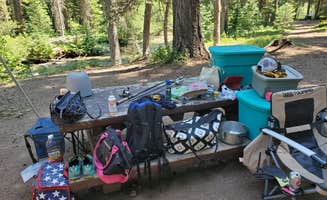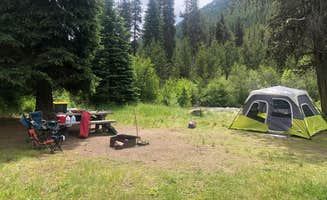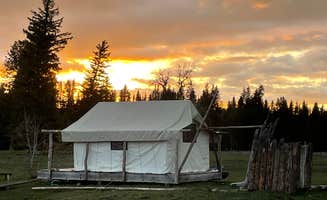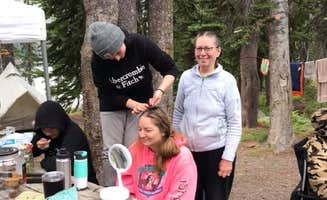Wallowa-Whitman National Forest spans over 2.3 million acres across northeastern Oregon and western Idaho, with elevations ranging from 1,000 to over 9,800 feet at the Eagle Cap Wilderness peaks. The forest contains diverse ecosystems from alpine meadows to dense pine forests. Summer temperatures typically range from 70-85°F during days and 40-50°F at night, while spring and fall bring significant temperature fluctuations that campers should prepare for.
What to do
Hiking near Eagle Cap Wilderness: Hurricane Creek Campground serves as a perfect base for accessing Hurricane Creek Trail into the Eagle Cap Wilderness. According to one camper, "Hurricane Creek Campground is super nice. Sits right along Hurricane Creek and has a lot of well maintained spots. My one caution would be that if you have dogs keep them on a leash because if they were to get in the creek that would be all she wrote. That creek is appropriately named as it really moves."
Wildlife viewing: Camping areas throughout Wallowa-Whitman National Forest offer excellent wildlife spotting opportunities. At Grande Hot Springs RV Resort, one visitor reported, "The resort lies next to a wildlife refuge. There are many birds." Another camper at the same location shared seeing "huge bull frogs, tadpoles, and fish. Also saw mule deer."
Alpine exploration: For spectacular mountain scenery, take the tram at Wallowa Lake. A reviewer at Wallowa Lake State Park Campground shared, "We took the tram up and visited a mountain summit 3700 feet above our location at the campground. There were numerous hiking trails, and fishing was a popular pastime for many campers."
What campers like
Natural hot springs: The mineral-rich waters at Grande Hot Springs RV Resort provide therapeutic benefits. A camper noted, "Our stay here was relaxing and fun. There are natural hot spring soaking pools at the campground. One pool is warm and the other is hot. I was grateful for the health benefits of the mineral soak."
Creek-side camping: Many Wallowa-Whitman National Forest campgrounds offer sites directly adjacent to flowing water. At North Fork Catherine Creek Campground, a visitor found "a nice secluded spot that was literally yards from the river. It was a primitive spot; it had no picnic table and only a fire ring made of rocks but since we had chairs we didn't mind."
Privacy between sites: Hurricane Creek Campground received praise for its layout: "This is a small campground with limited amenities, but a nice amount of privacy for each site. The creek lives up to its name and is very loud. The sites are not especially big, just enough space for two small tents."
What you should know
Road conditions: Many forest roads require careful driving. For Two Color Campground, a visitor warns: "Lots of blind corners, 1 lane with straight drop offs. If you have anxiety about cliffs, I do not recommend." Another camper noted: "Well graveled road. Expect washboards, potholes, and blind corners. 50 minutes from Medical Springs (last 18 miles), taking it easy with camper."
Limited services: Most remote campgrounds lack basic amenities. "No cell service for Verizon, sprint, and US cellular" at Two Color Campground, according to one reviewer. Another camper at North Fork Catherine Creek Campground cautioned: "THERE IS NO DUMPSTER so you have to pack all trash back out."
Weather variability: Mountain elevations bring unpredictable conditions. A visitor to Wallowa Lake State Park Campground reported: "We arrived in late November, when it was cold, snowy, and practically empty. But the campground and all of its facilities were open, and the camp host was extremely friendly and helpful!"
Tips for camping with families
Accessible recreation: Catherine Creek State Park Campground offers family-friendly facilities. A visitor mentioned: "There's a wonderful trail with a wooden bridge to start off. This area is heavily used, so if you like to be alone, might not be your thing, but the site is very well taken care of."
Entertainment options: Look for campgrounds with nearby activities. At Wallowa Lake State Park Campground, "There are go carts and mini golf nearby for families, and the gondola provides gorgeous views. You can hike, or ride up the mountains as well."
Wildlife education: Bear awareness is important at some sites. One camper at Wallowa Lake State Park Campground noted: "This is bear country so if thats not your thing, i wouldnt camp there. Lots of things to do close by both inexpensive and more expensive."
Tips from RVers
Site selection: Choose campsites that match your rig requirements. At Shady Campground, "Quiet- only 2 campsites. Primitive. Pic Nic table." While at Grande Hot Springs RV Resort, "Very nice RV park, very clean and well maintained. Roads and all sites are gravel. Lots of green grass areas and dog areas. All sites are pull through and can accommodate large RVs."
Seasonal considerations: Fall camping offers more space. "We came in early October, and had lots of space to ourselves. Easy drive-through spots and friendly campers," shared an RVer at Grande Hot Springs RV Resort.
Utility limitations: Plan for limited hookups in forest campgrounds. At Catherine Creek State Park, sites are "close to the river, mountain highway (only 2 lanes) and steep hillside with some grazing cattle on the other side. While the toilet facilities are a bit older, they flush and are clean where it counts."












